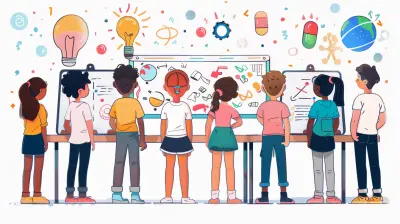15 August 2025
If you’ve ever found yourself reading the same page over and over without anything sticking, you’re not alone. We’ve all been there—hours spent highlighting textbook pages, thinking we’re "studying," only to realize later that none of it went in. That’s exactly where active learning comes into play.
In this article, we’ll break down what active learning really is, why it works, and how you can start using it today to actually retain what you study. Let’s stop wasting time and start studying smarter.

What Is Active Learning, Anyway?
Put simply, active learning is a way of studying that forces you to do something with the information you're trying to learn. Instead of passively re-reading notes or scanning textbook chapters, you engage directly with the material—asking questions, summarizing ideas in your own words, solving problems, or teaching others.Think of the brain like a muscle. If you just stare at the weights, nothing happens. But once you start lifting, those muscles get stronger. Active learning is your brain’s workout.

Why Traditional Studying Falls Flat
Let’s be honest. A lot of us think we’re studying when we’re really just reviewing. Highlighting, re-reading, and copying notes feel productive, but they don’t do much to actually move the info from short-term memory to long-term memory.Here’s why:
- Passive methods don’t require your brain to process the information.
- You’re not challenging your understanding or recalling anything.
- There’s no feedback loop to correct mistakes or reinforce right answers.
Sure, reading has its place, but it shouldn’t be the only thing you do. Active learning fixes this.

The Science Behind Active Learning
You don’t just have to take my word for it. Research consistently shows that students who use active learning techniques perform better, retain knowledge longer, and feel more confident in their understanding.Why? Because active learning taps into key cognitive processes:
- Retrieval Practice: Forcing your brain to recall info strengthens memory.
- Elaboration: Explaining ideas in your own words builds deeper understanding.
- Interleaving: Mixing up topics helps you make connections and learn better.
- Metacognition: Thinking about how you think improves how you learn.
In short—it’s not about the hours you spend, but how you spend them.

10 Active Learning Strategies That Actually Work
Let’s get practical. Here are ten bulletproof strategies you can start using today to make your study sessions more active and engaging.1. Teach What You’ve Learned
You don’t really get something until you can explain it to someone else. It’s called the Feynman Technique, and it’s one of the best ways to see if you truly understand something.Try this:
- Pretend you’re teaching a class.
- Use simple language.
- Run through a concept without relying on notes.
If you get stuck, that’s a sign you need to revisit that area.
2. Ask and Answer Your Own Questions
Become your own quizmaster. Instead of just reading, ask yourself:- What’s the main idea here?
- Why does this matter?
- How does this relate to what I already know?
Then, answer those questions out loud or in writing. Bonus points if you swap questions with a study buddy.
3. Use Flashcards (But the Smart Way)
Flashcards are a classic for a reason, but don’t just flip through them mindlessly. Use spaced repetition tools like Anki or Quizlet to review cards at optimal intervals. This taps into the spacing effect, helping you remember info longer.Pro-tip: Include cards that ask for application, not just definitions.
4. Summarize and Reframe
Once you've read a section, close your book and write a short summary in your own words. Even better, reframe the concept as a story, analogy, or even a comic strip. The sillier, the better—your brain loves vivid, creative connections.5. Apply Concepts to Real Life
Abstract ideas can be hard to grasp. Try to connect what you're learning to real-world examples. Studying supply and demand? Think about concert tickets. Reviewing Newton's laws? Watch a skateboarder in action.Linking theory to reality makes information way more memorable.
6. Use Mind Maps
Forget rigid outlines—mind maps are visual, dynamic, and perfect for showing relationships between ideas. Start with your central topic in the middle, then branch out with concepts, keywords, and examples. Add color and images if you’re feeling artistic.7. Practice Retrieval
Instead of going over your notes again, close them and try to write down everything you remember. Then, check what you got right and what you missed. This act of pulling information from memory is what strengthens it.Remember: testing isn’t just assessment—it’s learning.
8. Work in Study Groups (The Right Way)
Group study can be amazing if done correctly. Don’t just read together—quiz each other, debate ideas, or role-play as opposing viewpoints. The key is interaction, discussion, and accountability.Just make sure it doesn’t turn into a gossip session. Keep your focus.
9. Use Interleaving Instead of Cramming
Instead of sticking to one subject for hours (a.k.a. blocking), try mixing in different but related topics within a single study session. It may feel harder, but it actually improves understanding and recall.For example:
- Study algebra, then switch to geometry.
- Review cellular biology, then jump into genetics.
It keeps your brain on its toes.
10. Reflect and Self-Assess
At the end of a study session, take a few minutes to reflect:- What did I learn today?
- What was confusing?
- What do I need to revisit?
Self-assessment helps reinforce what worked and guides your next steps.
Tips for Getting the Most Out of Active Learning
Active learning sounds great, but how do you make it stick?Here are some quick tips to take it to the next level:
- Plan Ahead: Know what you want to achieve before each session.
- Use a Study Timer: Try the Pomodoro Technique (25 minutes study, 5 minutes break). It keeps you focused and avoids burnout.
- Track Your Progress: Keep a journal or checklist of topics mastered.
- Switch It Up: Don’t use the same strategy every time—variety keeps it fresh.
- Stay Honest: Don’t fool yourself into thinking you know something if you can’t explain it.
How to Turn Any Subject into an Active Learning Opportunity
Not every subject feels hands-on. So how do you bring active learning into more theoretical or abstract topics?Here's how:
For History or Literature:
- Act out scenes or debates.- Create timelines or storyboards.
- Summarize chapters as tweets or TikToks.
For Math or Science:
- Solve problems without looking at the solution.- Teach the process to a sibling or friend.
- Create your own practice questions.
For Languages:
- Practice speaking out loud.- Play vocabulary games or use language apps.
- Write short stories using new words.
Active Learning Isn’t Just for School
Here’s the kicker: active learning isn’t just a student thing—it’s a life skill. Whether you’re learning how to code, picking up guitar, or training for a job, these same techniques work.The brain doesn’t care what you’re learning. It just needs to be engaged.
Common Pitfalls to Avoid
Now, before you dive in, let’s cover some traps that can trip people up:- Mistaking Activity for Progress: Just because you’re doing something doesn’t mean it’s working. Make sure it’s challenging and thought-provoking.
- Doing It All Alone: Solo study is fine, but collaboration can improve understanding and keep you motivated.
- Overloading on Tools: Don’t get sidetracked by apps and gadgets. The method matters more than the medium.
- Ignoring Feedback: Always check your answers, reflect on mistakes, and adjust.
Wrapping It Up
Active learning flips the traditional study approach on its head. Instead of absorbing information like a sponge, you become an explorer—actively questioning, solving, and connecting the dots.Yes, it takes more effort. But it also works.
So the next time you sit down with your textbook, don’t just read. Interact. Challenge yourself. Use your brain like it was meant to be used—not as a storage unit, but as a thinking, learning machine.
Trust me, your grades (and your sanity) will thank you for it.








Oscar Vance
Great insights on active learning! Engaging with study material truly enhances understanding and retention. Thank you!
December 1, 2025 at 4:55 AM